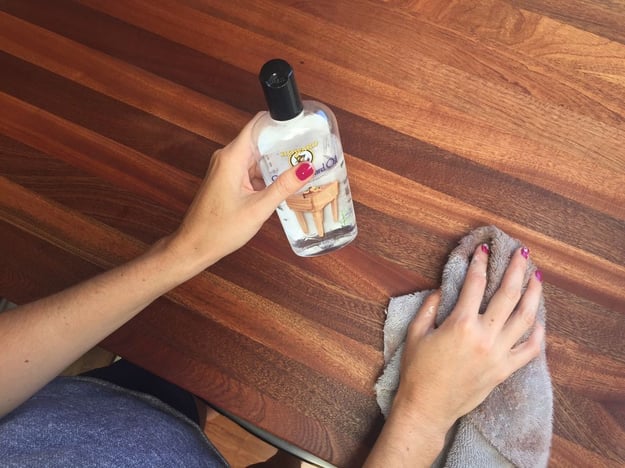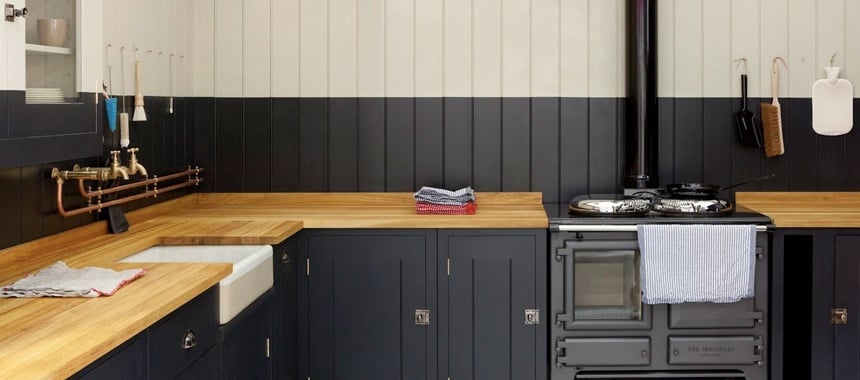It’s no secret that butcher block countertops are a favourite of many for kitchens. These wooden countertops offer a unique look and can make for a cozy kitchen feel. However, it’s also not news that butcher block requires a bit more upkeep than other countertop materials.
To look after your butcher block countertops, follow our tips below for cleaning and oiling your wooden countertops to maintain and preserve their beauty.
How to Clean Butcher Block Countertops
Daily Cleaning
Butcher block countertops should be cleaned after use. This means, you’ll likely be cleaning your kitchen countertops daily if you spend a decent amount of time preparing and cooking food. Luckily, daily cleaning doesn’t take a lot of time and doesn’t require any special materials.
After working on your butcher block countertops, try to clean the wood immediately before the grain has a chance to absorb stains and become discoloured. If food residue is left behind on the countertops, use a plastic spatula or another smooth, flat tool to scrape away the residue. Then, sponge down the wood surface with mild dishwashing soap.
In addition to mild dishwashing soap, you can also use undiluted vinegar to clean your wood countertops. Undiluted vinegar will clean and disinfect the butcher block without leaving behind a strong smell. Simply spray the area with white vinegar and let it sit for a few minutes. Then, return to the butcher block and wipe it down with a damp dishtowel. Make sure to let the countertop dry very thoroughly before putting anything back on top of the counter. This will help ensure that if any moisture is still there—which it probably is—what is left will air dry evenly.

Removing Stains
Over time—even those who consistently care for their butcher block countertops—will encounter a stain. There are a few stain removal methods you can try on your countertops before needing to sand the butcher block.
First, try using lemon. Sprinkle a little coarse salt onto the stained area of the countertop and then rub the area with half of a lemon. If the stain doesn’t vanish immediately, try using soap or vinegar after the area has dried.
Another direction you can take with wooden countertop stain removal is to try using baking soda. Baking soda works especially well on a fresh or recent spill. Begin by coating the stain in the powder. Then, rub the powder in and let it sit. After, scrub the area with either soap or vinegar and a moist sponge, Bob Vila recommends.
If these cleaning tips don’t do the trick, use bleach. Note that the bleach may discolour the wood. For this method, mix equal parts of water and bleach. Then, apply the mixture to the black using a slightly damp sponge or rag. For more stubborn stains, you may need to let it saturate overnight, Houzz recommends. When you’ve given the bleach mixture enough time to do its job, wipe down the surface and apply vinegar to neutralize the bleach.
If a stain just doesn’t seem to budge, try lightly sanding the counters with a medium sandpaper block. The area might look a little lighter after sanding it, but it should blend in after a month or two, A Couple Cooks says. After sanding, wipe off all the dust with a slightly damp rag. Then, reseal the wood using wax.

Oiling Butcher Block Countertops
When oiling butcher block countertops, you have a few food-safe mineral oil and conditioner options to choose from. If you want the shiniest, most revived look possible, The Kitchn recommends using a combination of mineral oil and beeswax.
Before using oils, check if your surface has a coating such as polyurethane, lacquer, or varnish. If your butcher block countertops are coated with a glossy finish, sand the wood before applying any oils.
For regular upkeep and to help keep the surface of your wooden countertops stain-repellent, food-safe mineral oil should be used. Using mineral oil will give your countertops more of a matte sheen than other options. You can also use walnut oil in the same way as mineral oil. When it comes to oiling your wooden countertops, be sure to avoid culinary oils such as olive, vegetable, and flax oils, as these liquids will oxidize and go rancid.
How to Apply Mineral Oil or Walnut Oil to Butcher Block Counters
- Clean the countertop to remove stains and dirt.
- Once the countertop is dry, apply one coat of mineral oil and let it soak in for about half an hour.
- After approximately 30 minutes have passed, apply the second application of the mineral oil and allow it to soak in.
- Once the second coat of oil has soaked in, wipe the surface down with a clean cloth.
If you’re looking for a noticeable transformation of your butcher block, try using butcher block conditioners containing a combination of mineral oil and beeswax, The Kitchn suggests. Before the first wax application, make sure to sand your wooden countertop and prepare the surface.
How to Apply Butcher Block Conditioners
- Clean the countertop to remove stains and dirt.
- Sand the countertop if necessary. (Check the label on the conditioner you’ve purchased to see what’s recommended.)
- Apply the conditioner as the label directs. (Usually, this means letting the conditioner soak in for a period of time before wiping off excess.)
Maintaining a kitchen can be hard work, but in the end, it’s always worth the extra effort. For more information on kitchen upkeep, visit your local Kitchen & Bath Classics showroom. No matter what your kitchen style may be, our experts are here to help you create the perfect look.



